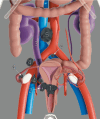Staging by imaging in gynecologic cancer and the role of ultrasound: an update of European joint consensus statements
- PMID: 38438175
- PMCID: PMC10958454
- DOI: 10.1136/ijgc-2023-004609
Staging by imaging in gynecologic cancer and the role of ultrasound: an update of European joint consensus statements
Abstract
In recent years the role of diagnostic imaging by pelvic ultrasound in the diagnosis and staging of gynecological cancers has been growing exponentially. Evidence from recent prospective multicenter studies has demonstrated high accuracy for pre-operative locoregional ultrasound staging in gynecological cancers. Therefore, in many leading gynecologic oncology units, ultrasound is implemented next to pelvic MRI as the first-line imaging modality for gynecological cancer. The work herein is a consensus statement on the role of pre-operative imaging by ultrasound and other imaging modalities in gynecological cancer, following European Society guidelines.
Keywords: cervical cancer; cross-sectional studies; ovarian cancer; uterine cancer; vulvar and vaginal cancer.
© IGCS and ESGO 2024. Re-use permitted under CC BY-NC. No commercial re-use. Published by BMJ.
Conflict of interest statement
Competing interests: None declared.
Figures








References
-
- Van Calster B, Van Hoorde K, Valentin L, et al. . Evaluating the risk of ovarian cancer before surgery using the ADNEX model to differentiate between benign, borderline, early and advanced stage invasive, and secondary metastatic tumours: prospective multicentre diagnostic study. BMJ 2014;349:g5920. 10.1136/bmj.g5920 - DOI - PMC - PubMed
-
- TNM classification of malignant tumours, 8th Edn. 2016.
Publication types
MeSH terms
LinkOut - more resources
Full Text Sources

